After nearly six months of preliminary work, the APM Task Force now is focusing on developing a vascular-specific Advanced Alternative Payment Model.
From March to June, the task force examined existing APM models and the CMS (Centers for Medicare & Medicaid Services) criteria for acceptance. "Task force members also studied other physician-focused APM proposals, developed by societies similar to the SVS, to expand their knowledge about the application process. Similar methodologies will be applied to vascular conditions in our APM," said Dr. Yazan Duwayri, task force chair.
An Alternative Payment Model (APM) is a bundled payment approach that provides added incentives for high-quality and cost-efficient care. It is one of two payment approaches included in the new Medicare reimbursement program, created with the Medicare Access and CHIP Reauthorization Act (MACRA) of 2015. The second alternative is Merit-based Incentive Payment System. "The long-term advantage of APM participation lays in the way the MACRA law is constructed, which allows for higher future payment updates for physicians participating in APMs," said Dr. Duwayri. Those in Advanced APMs can get a 5 percent bonus as well as a potential bonus payment structured into the methodology of the Advanced APM, he said.
"The overall goal is to create an APM that will be financially relevant to SVS members, by including diagnoses and procedures that constitute a large portion of vascular surgery practices," he said. "We also need to focus on procedures that currently result in high Medicare cost share and have value improvement potential to qualify the APM under CMS rules." The group needs to create models with sufficiently high volume and possibilities for interventions that can yield improved outcomes and cost savings that CMS will find attractive and, at the same time, provide sufficient savings to be reallocated back to the practice as a 5 percent bonus.
"The handful of APMs already accepted primarily take a bundled payment approach for either procedures or disease episodes," said Dr. Duwayri. With that system, "both quality and costs are going to be measured and will result in incentives or penalties," he said.
After analysis, the group has tentatively selected dialysis access and peripheral arterial procedures as the two categories most likely to meet the desired criteria. However, Dr. Duwayri cautioned that this direction could change as the work evolves.
Next, two subcommittees will meet twice a month to begin the clinical "mapping" process. The subcommittees will specify the clinical logic around the current management strategies of these two disease categories.
This will allow the workgroup to define the cost that can be attributed to vascular surgeons in the management of patients over a specific period of time. By evaluating clinical guidelines and existing literature, the task force will also try to determine the opportunities for the most efficient and appropriate care to yield excellent outcomes. This will also be accomplished by analyzing CMS claims data to determine if the clinical pathways yield sufficient cost savings to qualify as an APM. This phase of the process is now slated for November through January 2018.
